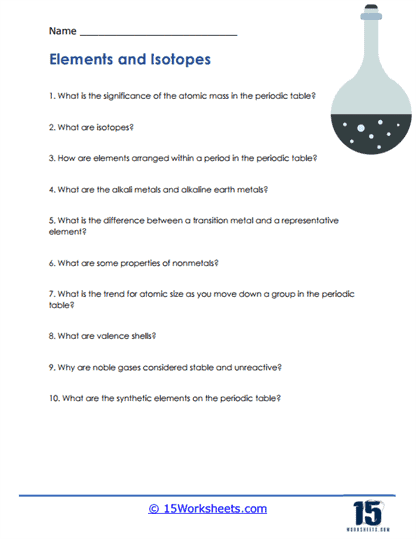Elements and Isotopes

Worksheet Description
The worksheet provides an insightful exploration into the world of atomic structure, emphasizing the significance of atomic mass, the concept of isotopes, and the systematic arrangement of elements on the Periodic Table. It further delves into specifics, probing the characteristics of alkali metals, alkaline earth metals, transition metals, and representative elements. Questions related to the properties of nonmetals, the trend in atomic size down a group, the significance of valence shells, and the stability of noble gases are posed. Lastly, it inquires about synthetic elements, which are man-made elements not naturally found on Earth.
To adeptly navigate and answer the questions in this worksheet, students should start with a foundational understanding of the Periodic Table and the significance of atomic mass, which represents the average mass of an element’s isotopes. They should familiarize themselves with the definition and characteristics of isotopes, which are variants of the same element differing in neutron count. A deeper dive into specific groups, such as alkali metals and transition metals, will require students to distinguish between their unique properties and behaviors. Lastly, comprehension of the electron configuration, particularly valence shells, will be crucial in understanding the reactivity and stability of various elements, especially the inert nature of noble gases.
The worksheet was created to instill a comprehensive understanding of atomic structures, isotopes, and elemental groups, cultivating a profound appreciation for the complexities of the Periodic Table. It encourages students to delve deep into the intrinsic properties and behaviors of specific elements and element groups, making distinctions and drawing comparisons. By probing into the nuances of atomic size trends, electron configurations, and the synthesis of non-natural elements, the worksheet emphasizes the intricacies of chemical science. Ultimately, its goal is to bolster students’ knowledge foundation, analytical skills, and curiosity about the atomic world, preparing them for advanced chemical studies.
